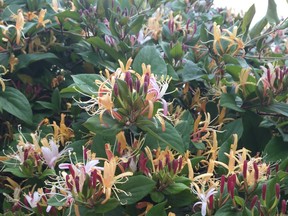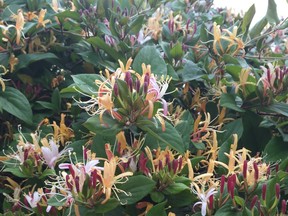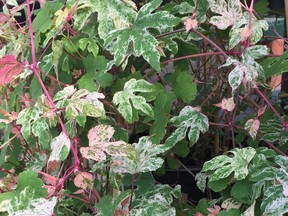Reviews and recommendations are unbiased and products are independently selected. Postmedia may earn an affiliate commission from purchases made through links on this page.
Brian Minter: Summer pruning requires an aggressive touch

Pruning at this time of the year can make a huge difference in the quality of your fruits and the shape, health and longevity of your trees and shrubs.

Article content
Pruning garden plants in summer is perhaps more important than the traditional dormant season trimming in winter. Pruning on cooler days will minimize the stress on your plants and prevent inside leaf burn. At this time of the year, vines, in particular, need extra attention because they tend to overgrow. We love vines for the privacy and the unique accents they provide, but they often don’t know when to quit. Summer-flowering vines, like clematis, honeysuckles, trumpet vines (campsis) and wisterias, should all be encouraged to develop new stems for future flowering, but they can quickly overtake their allotted space.
Advertisement 2
Article content
Most of us are a too conservative in our pruning techniques. We should recognize not only the importance of retaining the flowering stems but also the need to prune all the other branches back hard as they will quickly start to regrow.
Wisterias, especially the repeat-flowering varieties, like Blue Moon need to have thicker, woody vines for the production of flowers, but we can say goodbye to most of the new growth they produce. It’s a balance of developing future flowering stems while keeping much of the vigorous growth in check.
Early flowering clematis, like the alpinas, the macropetalas and the montanas, need older, mature growth to develop their spring buds, but here too, only so much is needed.
Don’t be gentle with non-flowering vines, particularly Virginia creeper and Algerian ivy. If you are too timid, they’ll quickly stampede beyond their assigned walls, trellises or arbours.
Because we’re so focused on the fruit, we don’t use grapes as a decorative vine nearly enough. Whatever their role, grape vines need regular attention. When you cut them back, be sure to leave enough leaf cover to protect the fruit clusters from burning in extreme heat.
Article content
Advertisement 3
Article content

Many kiwi varieties grow so quickly that it’s a challenge to keep up. When pruning, save enough leaves to protect the small fruits of the kolomikta variety and the large, fuzzy fruits of the big-leafed types.
Shade-loving climbing hydrangeas, Hydrangea petiolaris, and their cousin, H. schizophragma, seldom grow out of control, but they still need to be kept in check by cutting back any more vigorous growth, while retaining enough new growth to develop next year’s buds, which are now forming.
Honeysuckle vines, unfortunately, are quite susceptible to many fungal diseases, especially during wet summer weather, and they are magnets for aphids. Because they bloom on new growth, a hard pruning of diseased or infected vines will keep them cleaner and still able to re-flower quite quickly.
Many fruit trees, especially peaches and nectarines, are really pushing out lots of growth at this time of the year. Two issues should be considered when pruning them. Always leave enough branches around the fruit to prevent sun scald, and keep in mind that the best fruiting branches are the ones that grew 45 to 60 centimetres this growing season. When you begin to cut back excess growth on peaches and nectarines, remember to save enough of the branches that will reach this increased length, but at the same time, remove the growth that is cluttering up the tree and shading the fruit.
Advertisement 4
Article content

Apples, pears, Asian pears and plums are also full of new growth now and are pushing the size of the trees, perhaps to dimensions far larger than you want. The goal should be to train their branches in a horizontal fashion so that they are not only more inclined to set buds and spurs, but also to control the size of the trees. Try to open up the centre of the trees to allow better air circulation and to let in more sunlight to help ripen the fruit and develop new spurs and flower buds.
The popular espalier tree forms, where branches are trained along fence lines, need pruning as well to maintain this unique form. When you prune the mostly upright growth on these horizontal stems, try to leave at least one or two nodes; a spur can often develop at these nodes and produce fruit. It’s important to maintain the integrity of the tree’s shape while developing new fruiting spurs for the future.
Summer is one of the best times to prune Japanese maples to keep them at a good size and in the shape and form you want. The nice thing about summer pruning is the tree’s ability to re-flush quickly with new growth. In winter, some branches just don’t grow out again — often because of a disease called anthracnose. Even the smaller weeping forms can quickly grow far larger than the space they’re allowed, so pruning them is very important. It also makes a positive difference in the profile of each tree in your landscaping.
Advertisement 5
Article content
Flowering shrubs also need attention at this time of the year, but you need to be very careful not to prune off next year’s buds. The golden rule is to prune all flowering shrubs back right after they finish flowering to ensure the plants have enough time to set buds for next year. In summer, most flowering occurs on new growth, but a light pruning after flowering helps maintain the plant’s form. Additional pruning may be necessary in spring to cut the plant farther back to a size and silhouette you like. Even larger flowering trees can be trimmed and tidied up in summer to keep them well proportioned.
The one concern I have is for the many old varieties of macrophylla or mophead hydrangeas. They grow quickly to a large size and must be pruned by the end of July to make sure they have enough time to produce new growth and set buds for next spring.
Most evergreens can be pruned back now, especially in early July when many conifers take a quick break in growth. Junipers, cedars, yews and cryptomerias could all use a summer trim, but spruce, pine, fir and abies should have been pruned earlier when last year’s candles and buds popped.
Pruning at this time of the year can make a huge difference in the quality of your fruits and the shape, health and longevity of your trees and shrubs.
Recommended from Editorial
Article content
Source: vancouversun.com



